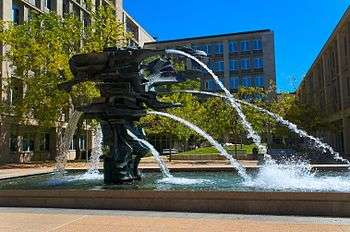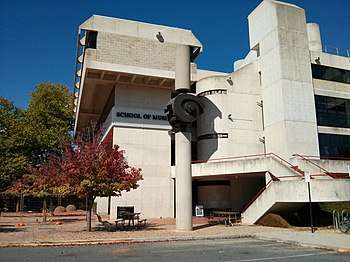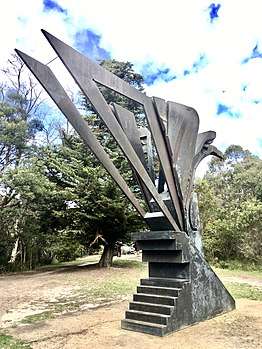Norma Redpath
Norma Redpath OBE (20 November 1928 – 12 January 2013) was a prominent Australian sculptor.[1]
Norma Redpath | |
|---|---|
| Born | Norma Redpath 20 November 1928 |
| Died | 12 January 2013 (aged 84) |
| Nationality | |
| Education | Swinburne Technical College and Universita per Stranieri in Perugia |
| Known for | Sculpture |
Notable work | Treasury Fountain, Canberra |
| Movement | Centre 5 |
| Awards | OBE |
Life and work
Norma Redpath studied painting from 1942 to 1948 (with a long break due to illness) at the Swinburne Technical College in Hawthorn, and from 1949 to 1951 sculpture at the Royal Melbourne Institute of Technology, both in Melbourne. Her studies there were largely self directed as she found no contemporary sculpture of interest to her in Australia.[2]

While still a student, she was invited to be a member of the Victorian Sculptors' Society (VSS), where she exhibited, and was later Vice President.
In 1953 she was a founding member of the 'Group of Four' with Inge King, Julius Kane and Clifford Last.
During the fifties, she traveled to Europe, and studied in Italy from 1956 to 1958 at the Universita per Stranieri in Perugia, developing a love for Italy and Italian art.[2]
In 1958 she returned to Australia to take up a teaching post at the Swinburne Technical College, and became a founding member of the renowned 'Centre Five' group of sculptors in 1959, a group which expanded from the 'Group of Four' to add (among others) Lenton Parr, Vincas Jomantas and Teisutis Zikaras, who broke with the VSS and organised private exhibitions.[1] In 1960, she was one of the artists selected for the National Gallery of Victoria’s Six Sculptors exhibition, which was the first exhibition of local modernist sculpture by the Gallery.[2]

By 1961 she had decisively turned to bronze, with Dawn figure, a plaster cast envisaged for casting which was awarded the inaugural Mildara (later Mildura) Prize for Sculpture.[2] The same year she won both the Italian Government Travelling Scholarship and the Dyason Bequest travelling scholarship.[2] In 1962 she pursued her studies at the Accademia di Belle Arti di Brera in Milan, where she would later make a base as she traveled frequently back and forth between Italy and Australia. Sculptures cast there formed the basis of her Gallery A exhibition in Melbourne the following year. One of the sculptures was awarded her second Mildara Prize for Sculpture in 1964, and in 1966 she won the Transfield Prize for Sculpture.[2] In 1968 she returned to Melbourne, establishing a studio in Parkville, where she worked on a number of major commissions.[1]

In 1970 Norma Redpath was appointed an Officer of the Order of the British Empire for services to contemporary sculpture.[3][2]
In 1974, while again in Italy, Redpath married Antonio de Altamer, an Italian naval architect. The worked together to refine the technical procedures of the Fonderia Artistica Battaglia and other foundries in the next decade.[1] From the late 1970s she ceased studio work, instead describing her sculptural ideas in a manuscript, Ideas and Images.[2]Sculpture at the ANU School of Music April 2013.jpeg
From 1974 to 1985 she lived and worked alternately in her Milanese studio and Melbourne, and from 1985 she returned to Australia with her husband and set up her third Australian sculpture studio in Carlton. Redpath's husband died in 2000, the same year as her last show, at the Heide Museum of Modern Art.[1]
In 2006 she was awarded an honorary doctorate from her old college, now Swinburne University. After a long illness, she died in Melbourne in 2013, aged 84.[1]
Works (selected)
- Areopagitica (1958), Baillieu Library, University of Melbourne
 Landscape Caryatide1(1985), at McClelland Gallery and Sculpture Park
Landscape Caryatide1(1985), at McClelland Gallery and Sculpture Park - Bronze Reliefs (1964), BP Administration Building, Crib Point, Victoria - relocated to BP building South Melbourne, relocated again to the McClelland Gallery and Sculpture Park in 1997. (image and details)
- Treasury Fountain (1965–1969), Treasury Building, Canberra (ACT) – a two-piece bronze fountain in a rectangular granite pond.
- Victoria Coats of Arms (1968), above entrance, National Gallery of Victoria, Melbourne– a bronze relief
- Sculpture Column (1969–1972), Reserve Bank of Australia, Brisbane
- Facade Relief (1970–1972), Victorian College of Pharmacy, Parkville, Melbourne
- Sydney Rubbo Memorial Capital (1970–1973), Microbiology and Immunology Building Courtyard, University of Melbourne
- Higuchi Sculpture (1971–1972), Manning Building at the Monash University in Melbourne - unveiled by Dr. Takeru Higuchi details in pdf document page 6
- Extended Column (1972–1975), Canberra School of Music, Canberra
- Paesaggio Cariatide (Carrying the Landscape) (1980–1985), undercroft of State Bank Centre, Bourke Street, in Melbourne - since 2003 at the McClelland Gallery and Sculpture Park in Langwarrin, Victoria[4]
References
- Wasch, Kenneth (23 January 2013). "Australian sculptor who was enamoured with Italy". The Age. Retrieved 24 February 2013.
- Mendelssohn and Kirby, Joanna and Sandy. "Bibliography". Design and Art Online Australia. Retrieved 24 February 2013.
- "Its an Honour". AUSTRALIAN HONOURS SEARCH FACILITY.
- "Norma Redpath: Works from the Studio, 1970s & 1980s". Charles Nodrum Gallery. Retrieved 19 March 2020.
Further reading
- Man sights an object in space : Norma Redpath's approach to public art by Jane Eckett, Art Monthly Australia Volume 259, pages 62–64.
External links
| Wikimedia Commons has media related to Norma Redpath. |